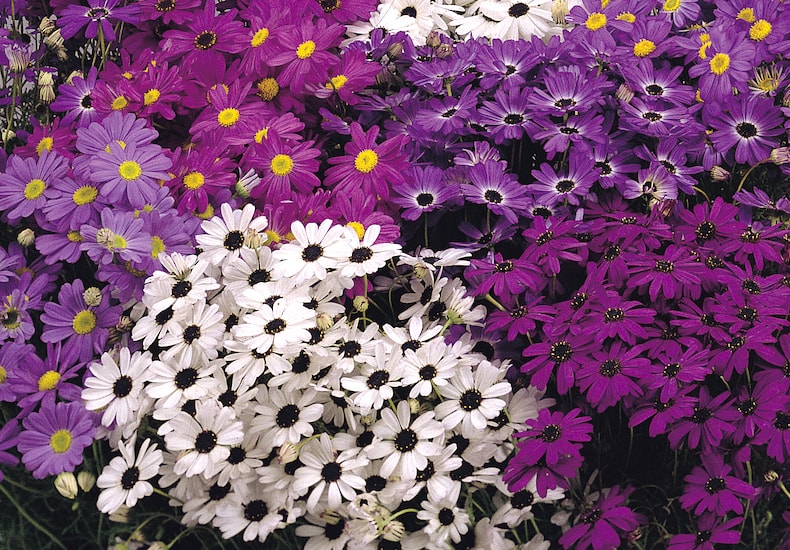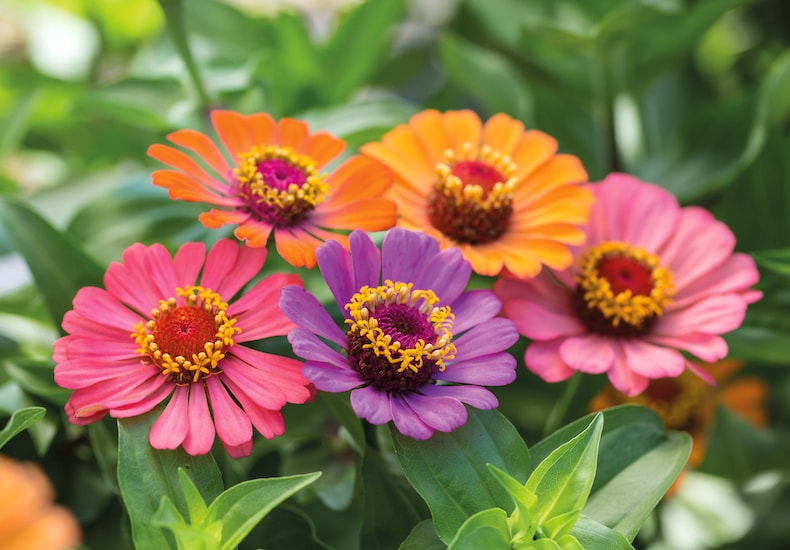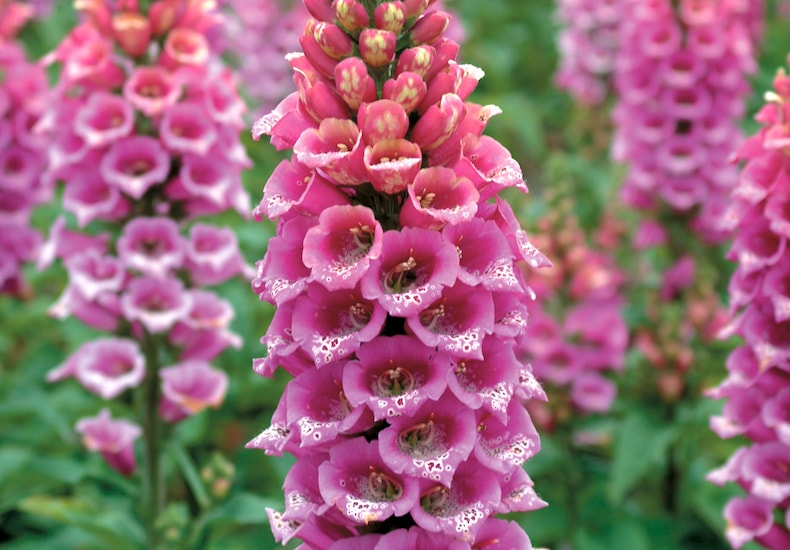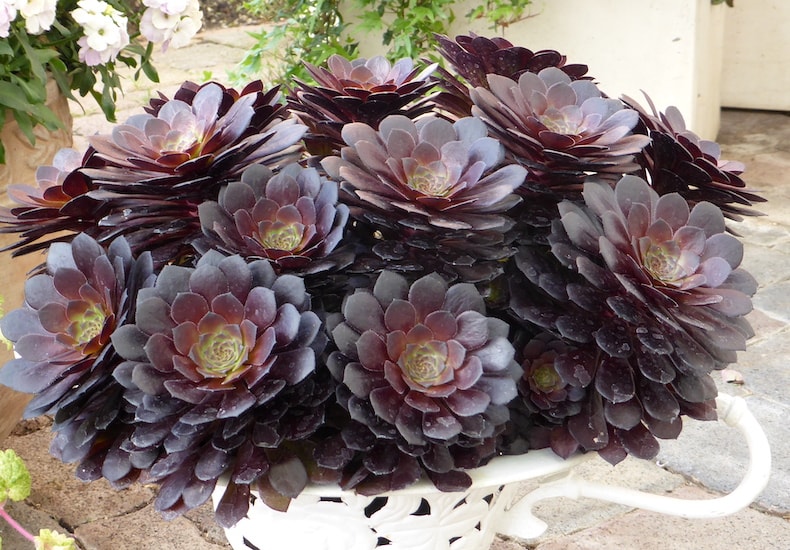Plants that flower once

Grow Swan River Daisies in containers or borders
Image: Brachyscome iberidifolia 'Bravo' from T&M
Plants that flower and fruit only once in their lives rely on seed to perpetuate themselves. Here, botanist Daan Smit of Vrije Universiteit in Amsterdam discusses the different types of monocarpic plants.
Browse our full range of flower seeds for even more inspiration.
What is a monocarpic plant?
There are many distinct growth forms in the plant world, and monocarpic plants represent one of the most curious. The word monocarpic derives from the Greek words ‘monos’ meaning single, and ‘karpos’ meaning fruit. This describes the fact that they die after a single cycle of flowering and production of seeds. This feature of flowering and fruiting just once before dying distinguishes them from the other main group, the polycarpic plants, which fruit more than once before dying.
Monocarpic plants can be divided into annuals, biennials and perennials:
- Annuals flower, fruit and seed in one year
- Biennials take two seasons
- Perennials sometimes take many years to flower
Monocarpic annuals

Zinnias are drought-tolerant flowers that are easy to grow
Image: Zinnia 'Forecast' from T&M
Monocarpic annuals are probably the most familiar. They consist of plants which germinate, grow, flower, produce seed and die all within one growth season - sometimes within just a few months or even weeks. Most don’t have the time to produce very large plants although some, like the sunflower, (Helianthus annuus) can produce plants up to 10ft (3m) in height.
Most of the plants grown for summer bedding fall into this group, as well as many cut flowers and all hardy annuals, together with a number of irritating weeds. Within a very short time of sowing, they produce masses of flowers followed by an abundant supply of seeds which are distributed by wind, by animals and birds or which simply drop near the parent plant. They then remain in the soil until conditions are favourable the following year.
Some annuals germinate in the spring and quickly grow, flower and set their seed, while others germinate in late summer and overwinter as rosettes before flowering as the temperature increases and the weather becomes drier. In both cases flowering finishes and seed ripens as warm, dry conditions suitable for seed ripening occur.
Many of the annuals are very familiar - alyssum, aster, eschscholzia and zinnia for example - but two which are not grown as often as they should be are the Swan River daisy and the pink Hawksbeard.
- Swan River daisy (Brachycome iberidifolia) grows wild in South Africa and has flowers in a daisy-like head. It can flower in just 6-8 weeks after sowing with white, pink, lilac or purple flowers and many in between shades on plants up to 12in (30cm) high. It likes a sunny spot in the garden and will thrive in window boxes, tubs and pots. Apart from this mixture there are also some separate colours such as 'White Splendour' with pure white flowers and ‘Purple Splendour' with rich purple-blue flowers.
- Pink Hawksbeard (Crepis rubra) is another of the many annuals in the daisy family, this time from southern Europe. It produces large numbers of flowers on erect stems up to 12in (30cm) high and is especially suitable for cutting for mixed bouquets. In spite of the name rubra its flowers are not red but pink and there is also a white flowered form, 'Snow White'.
A number of plants are treated as annuals although they’re actually perennials which flower in their first year of growth. Petunias, antirrhinums and bedding salvias fall into this category.
Monocarpic biennials

A hardy biennial, 'Candy Mountain' is the first upward facing foxglove from seed
Image: Foxglove 'Candy Mountain' from T&M
The second and much smaller group is made up of biennials which have a two year growth cycle. In their first year they make vigorous growth, building up food reserves, often in the roots, and this energy is used to produce the flowers and seeds in the second year, after which the plant dies. This group includes a small number of good garden plants and some valuable cut flowers such as Sweet William, canterbury bells, sweet rocket and foxgloves.
A number of biennial plants produce attractive rosette foliage. Various species of Meconopsis and Verbascum in particular are worth growing for their foliage alone.
A biennial plant which deserves to be grown more often is the horned poppy (Glaucium). It is related to the more familiar field and alpine poppies (Papaver) and there are three species generally available. All have attractive foliage, long curved seed pods and grow best in very gritty, well drained soil in full sun. G. corniculatum from southern Europe has downy, finely cut, grey leaves and bright red flowers with a dark blotch at the base of each of the four petals. The brilliant yellow G. flavum has broader, less hairy foliage and especially long curved seed pods. In Britain it grows along the coasts on shingle and pebbles, sometimes only just above the high water mark. G. grandiflorum has red or orange flowers and olive green foliage.
Some biennials, including the horned poppy, can be grown as annuals if sown early in the year. Others, in particular the Meconopsis, can be persuaded to flower more than just once if the first year's flower spike is cut off before it develops fully.
A number of perennials are grown as if they were biennials because they flower well in their second season. Wallflowers, polyanthus, daisies, violas and hollyhocks can all be grown in this way. Not only do they flower in their second season but they flower less well in following years so they are often discarded and new plants grown from seed.
Many root vegetables such as carrots are derived from biennial plants. Their tendency to produce a fleshy root for food storage has been enhanced by selection and by the work of plant breeders to produce the fat, juicy, edible roots.
Monocarpic perennials

These succulent, leafy rosettes are ideal for sheltered patios or conservatories
Image: Aeonium arboreum 'Tip Top' from T&M
The third group of monocarpic plants is the large group of perennials. Unlike annuals and biennials, most of these are plants which originate in tropical and subtropical regions. Some of them, like the talipot palm (Corypha umbraculifera) from Ceylon, and Puya raimondii from the Andes, can take 50-70 years to flower, each year producing more leaves around the same central stem. When they eventually come into flower they then produce seed and die without even producing any offsets. But there is another group which, although the main plant dies after flowering, produces a number of offsets around the plant. Agave, from which tequila and sisal is made, may take 30-50 or even 100 years to flower and bananas fall into this group.
The most important family of monocarpic perennials is the bromeliads. These include some very familiar houseplants such as Billbergia, Aechmea, Vriesia and Guzmania. Wholesale growers of these plants manage to get flowering size plants in about two years from seed. To do that, a constant temperature of 68F (20C) is needed and a high humidity level. The best results are achieved by using fresh seed but their viability can be prolonged by storing them under cool, dry conditions. Most will lose their viability after a year. Seeds can be sown in a soil-less compost and kept covered with glass and constantly moist. They should germinate in 3-4 weeks. The seeds will swell after a few days to show that they are alive and have taken in water.
Two members of the crassula family, Aeonium and Aichryson are monocarpic perennials which are well worth growing. Aeoniums, almost all of which grow wild only in the Canary Islands, are especially suitable for anyone who wants to start collecting cacti and succulents since they are very easy to grow. The seeds germinate rapidly, usually within 2-3 weeks when sown at a temperature of 65-68F (18-20C). Some will flower within two years of sowing others may take 10-20 years before they flower. Of course they die completely after flowering but before they do so, most of them have produced offsets as well as large numbers of seeds.
Aichryson are similar and, if you can get the seed they make stunning plants with huge quantities of yellow flowers. They need a sunny sheltered spot in fairly dry conditions.
Perennial plants which take some years to flower then die at once can be vulnerable to natural disasters, especially if they produce seed and no offsets. They could be destroyed after some years’ growth without reproducing.
If you'd like more information and advice about growing annuals in your garden, visit our hub page for helpful sowing and growing resources.
Daan Smit is a botanist who is Curator of Vrije Universiteit in Amsterdam.
Source of article
Growing From Seed - Summer 1987 Vol. 1 Number 3
© The Seed Raising Journal from Thompson & Morgan
Sign Up For Exclusive Special Offers




© 2024 Thompson & Morgan. All rights reserved. A division of Branded Garden Products Limited.
Sign up for exclusive offers!



